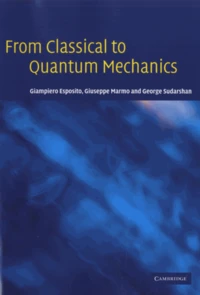From Classical to Quantum Mechanics. An Introduction to the Formalism, Foundations and Applications
Par : , ,Formats :
- Paiement en ligne :
- Livraison à domicile ou en point Mondial Relay indisponible
- Retrait Click and Collect en magasin gratuit
- Nombre de pages592
- PrésentationBroché
- Poids1.465 kg
- Dimensions18,0 cm × 25,5 cm × 3,5 cm
- ISBN0-521-83324-8
- EAN9780521833240
- Date de parution01/01/2005
- ÉditeurCambridge University Press
Résumé
This book provides a pedagogical introduction to the formalism, foundations and applications of quantum mechanics. Part I covers the basic material that is necessary for an understanding of the transition from classical to wave mechanics. Topics include classical dynamics, with emphasis on canonical transformations and the Hamilton-Jacobi equation ; the Cauchy problem for the wave equation, the Helmholtz equation and eikonal approximation ; and introductions to spin, perturbation theory and scattering theory. The Weyl quantization is presented in Part II, along with the postulates of quantum mechanics. The Weyl programme provides a geometric framework for a rigorous formulation of canonical quantization, as well as powerful tools for the analysis of problems of current interest in quantum physics. In the chapters devoted to harmonic oscillators and angular momentum operators, the emphasis is on algebraic and group-theoretical methods. Quantum entanglement, hidden-variable theories and the Bell inequalities are also discussed. Part III is devoted to topics such as statistical mechanics and black-body radiation, Lagrangian and phase-space formulations of quantum mechanics, and the Dirac equation. This book is intended for use as a textbook for beginning graduate and advanced undergraduate courses. It is self-contained and includes problems to advance the reader's understanding.
This book provides a pedagogical introduction to the formalism, foundations and applications of quantum mechanics. Part I covers the basic material that is necessary for an understanding of the transition from classical to wave mechanics. Topics include classical dynamics, with emphasis on canonical transformations and the Hamilton-Jacobi equation ; the Cauchy problem for the wave equation, the Helmholtz equation and eikonal approximation ; and introductions to spin, perturbation theory and scattering theory. The Weyl quantization is presented in Part II, along with the postulates of quantum mechanics. The Weyl programme provides a geometric framework for a rigorous formulation of canonical quantization, as well as powerful tools for the analysis of problems of current interest in quantum physics. In the chapters devoted to harmonic oscillators and angular momentum operators, the emphasis is on algebraic and group-theoretical methods. Quantum entanglement, hidden-variable theories and the Bell inequalities are also discussed. Part III is devoted to topics such as statistical mechanics and black-body radiation, Lagrangian and phase-space formulations of quantum mechanics, and the Dirac equation. This book is intended for use as a textbook for beginning graduate and advanced undergraduate courses. It is self-contained and includes problems to advance the reader's understanding.
